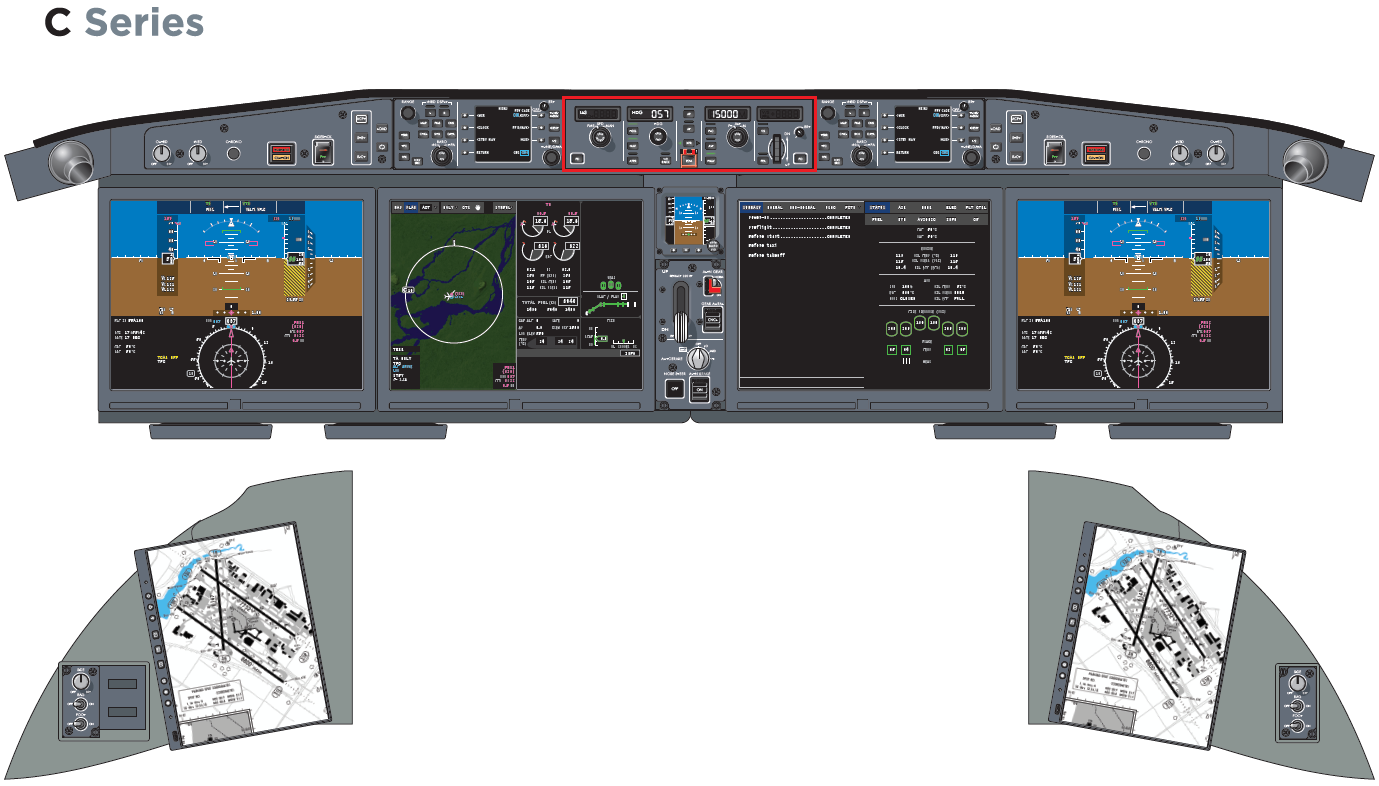Leeham News and Analysis
There's more to real news than a news release.
Leeham News and Analysis
- At long last, Boeing appears near certification and EIS for 777X
- Air India Flight 171 Preliminary Crash Report Is Unclear Regarding Pilot Actions
- Bjorn’s Corner: Air Transport’s route to 2050. Part 30.
- It’s official: MTU’s engine leader named CEO of Airbus Commercial from Jan. 1; future of Open Fan and A220-500 shifts to him
- Embraer E2: Where will the orders come from?
Bjorn’s Corner: Aircraft stability, Part 8
June 1, 2018, ©. Leeham News: In the last Corner, we discussed the how the Flight Management System (FMS) is the part which calls the shots in a high-end autopilot (or Automatic Flight Control System, AFCS, as it’s called in high-end business jets and airliners).
Now we will dig deeper into what happens once the FMS has figured out how we shall follow a route.
Figure 1. The Automatic Flight Control System (AFCS) panel of the CSeries (surrounded with red). Source: Bombardier.
The Automatic Flight Control functions
As described last week, the master unit in the Automatic Flight Control System is the Flight Management System, the FMS. The pilot can decide to fly the aircraft himself, with or without the Autopilot supporting him for the control movements and the FMS helping him to follow the route, or he can leave the task to the FMS.
When he flies the aircraft himself, he can set the FMS to show him how to steer to get the correct climb attitude, heading and so on to follow the flight path. The flight director shows this through the Flight Director bars, Figure 2.

Figure 2. Flight Director bars showing how to steer the aircraft to follow the flight path. Source: Google Images.
The Flight Director bars will tell him what pitch angle is the correct one for holding the climb speed after take-off and how he shall roll to keep the aircraft on the track.
During the cruise, the bars will tell him how to pitch the nose to keep the altitude and roll the aircraft to hold the flight plan track. It’s the same for the descent and approach.
The pilot often flies himself after take-off, until landing gear and flaps are retracted, and from time to time the final approach and landing to keep the proficiency. His flying is the back-up for all the automated systems and this requires the pilot to be proficient.
One also flies manually in case of severe turbulence, where the autopilot could react a bit to direct to large air movements and upset the passengers. A pilot can be softer in his corrections and therefore achieve a smoother flight.
The pilot gets the Flight Director bars on his screen by pressing the FD button on his side of the Flight Control Panel, Figure 3. If he then sets a Heading (HDG button and then set the heading on the display with the rotating knob next to the HDG button) the Flight Director crossbars will direct him to roll the aircraft to keep the heading, or if he presses Vertical Speed (VS to the right) and sets the vertical speed to for example -1000 feet/minute (as in Figure 3), the flight director bars will direct him to the correct pitch down attitude to reach 1,000 feet/minute descent speed.
If the pilot then presses the Autopilot button (AP in the middle), the Autopilot will take over the steering of the aircraft and follow the Heading and Vertical speed the pilot sets.
The pilot uses this capability to steer the aircraft directly through the controls on the Flight Control Panel when the situation along the route is dynamic.
This is often the case in the transition from descent to final approach (for a later ILS, RNAV or visual approach). The Air Traffic Controllers send the aircraft on different headings to puzzle them together for landing. By routing them dynamically, the last bit before the final approach, the controller can line the aircraft in a row, one after the other, with the needed distance between them for landing.
The programming of an FMS to change the flight plan according to the controllers’ orders is then too slow and cumbersome. It’s better for the pIlot to take control and command the autopilot to follow the ATC orders via the controls on the panel. He would, for instance, set a heading of 230° to intercept an ILS approach which would be 10 miles ahead and where the final localiser track would be 270°. Once the heading set and cleared for the approach by the Air Traffic Controller, he would arm the Flight Control system for the ILS approach (by pressing APPR on the panel). The APPR function would then take over the guidance and follow the ILS once it was established on the ILS localiser course and glide path.
In the next Corner, we will discuss the functions of high-end Flight Control systems which help with flying difficult approaches.
Share this:
- Click to print (Opens in new window) Print
- Click to email a link to a friend (Opens in new window) Email
- Click to share on X (Opens in new window) X
- Click to share on Pinterest (Opens in new window) Pinterest
- Click to share on Facebook (Opens in new window) Facebook
- Click to share on WhatsApp (Opens in new window) WhatsApp
- Click to share on LinkedIn (Opens in new window) LinkedIn
- Click to share on Tumblr (Opens in new window) Tumblr
- Click to share on Reddit (Opens in new window) Reddit
Related
Category: Bjorn's Corner, Bombardier
Tags: Autopilot, Bombardier, CSeries, flight control



